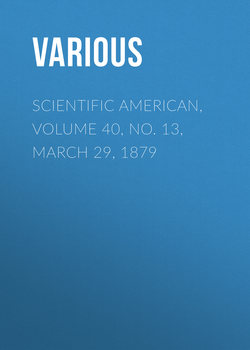Читать книгу Scientific American, Volume 40, No. 13, March 29, 1879 - Various - Страница 2
A NEW STEAM TILLER
ОглавлениеSteam is now made to perform almost everything in the way of heavy labor, to the saving of muscle and energy that may be more profitably employed; and since inventive genius has devised means of governing steam with absolute accuracy, there seems to be no limit to its economical application.
A recent invention in steam engineering, which exhibits in a marked degree the controllability and adaptability of steam, is Mr. Herbert Wadsworth's steam tiller, an engraving of which we present herewith.
This machine (Fig. 1) is provided with a steam cylinder, similar to the cylinder of a steam engine, containing a piston, the rod of which is attached to a crosshead, A, that slides on ways, B, secured to the bed supporting the cylinder.
The tiller, D, as it is carried to starboard or port, slides through a socket, E, pivoted to the crosshead.
The motion of the rudder is communicated to the steam cut-off by means of the shaft, C, crank, J, rod, K, crank, I, and the hollow valve spindle. When the tiller is amidships the valve handle, H, is at right angles to the cylinder, and parallel to the tiller. By moving the lever, H, to right or left, steam is admitted to one end or the other of the cylinder, which, acting on the tiller through the piston, piston rod, and crosshead, moves the rudder; and when the rudder reaches the desired position the cut-off will have been moved the amount necessary to prevent further entrance of steam. When the rudder is influenced by the waves or by the expansion or contraction of steam, the cut-off alters its position in relation to the valve and automatically arranges the steam passages so that the piston is returned to its proper position. The details of the cut-off are shown in Fig. 2; the valve, G, which covers the cut-off, F, acts like a four way cock. The spindle of the cut-off, F, is connected with the lever, I, and is moved by the rudder, as already described. By enlarging or gradually narrowing the ends of the steam ports great rigidity or elasticity may be given to the hold of this engine, according to the requirements of the particular vessel.
Few and simple as are the parts of this machine it is possible, by balancing the valves and suiting the diameter of the cylinder to the work to be performed, to overcome great resistances with a slight effort. The inventor says that this system of valves is considered by experts to be novel and very valuable.
In Fig. 3 is shown a pattern of a slide valve suited to special purposes. Its working is essentially the same as that of the valve already described. The ports are set side by side, parallel with the sides of the valve. The supply port is in the middle, the other ports lead to opposite ends of the cylinder.
In Fig. 4 is shown another application of the controlling valve and cut-off described above. Two oscillating steam cylinders are employed in working the rudder. They are placed on opposite sides of the chest, A, and are supplied with steam through the controlling valve, B. The piston rods of the two cylinders are connected with cranks placed on opposite ends of the shaft, C, at right angles to each other. Upon this shaft, half-way between the pillow blocks which support it, there is a worm which engages a toothed sector, D, on the rudder-post, E. To an extension of the rudder-post is secured an arm, F, which is connected with the arm, G, of the controlling valve. By shifting the lever, H, the supply of steam to the two cylinders may be increased or diminished, or its direction may be changed, so that the engines will be reversed or stopped. This engine is remarkable for its simplicity. The cylinders may be detached and changed if required, one size of bed answering for three different sizes of cylinder, which may vary only in diameter, the stroke being the same, so that the castings for engines of different power are the same except in the matter of the cylinders and pistons, and all the parts are interchangeable—a feature of modern engine building that cannot be too highly valued.
Further information may be obtained from Herbert Wadsworth, 26 Merchants' Bank Building, 28 State street, Boston, Mass.
